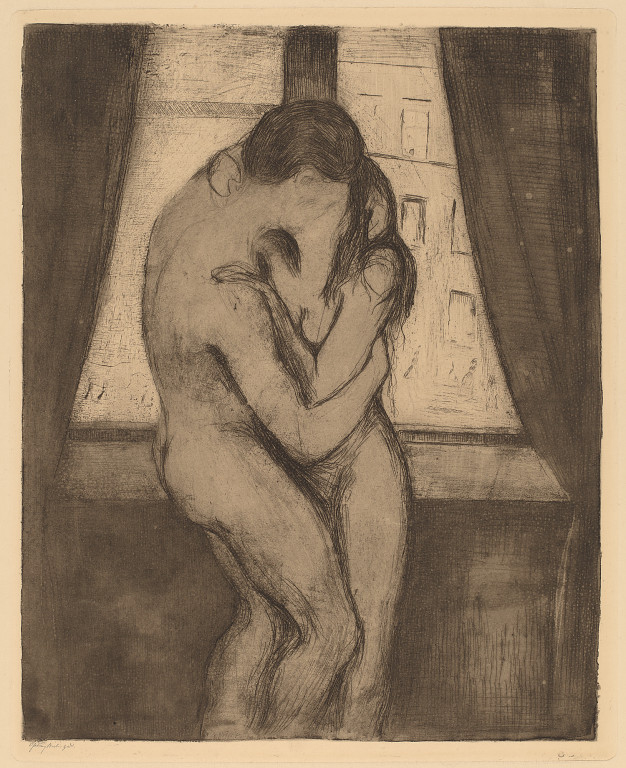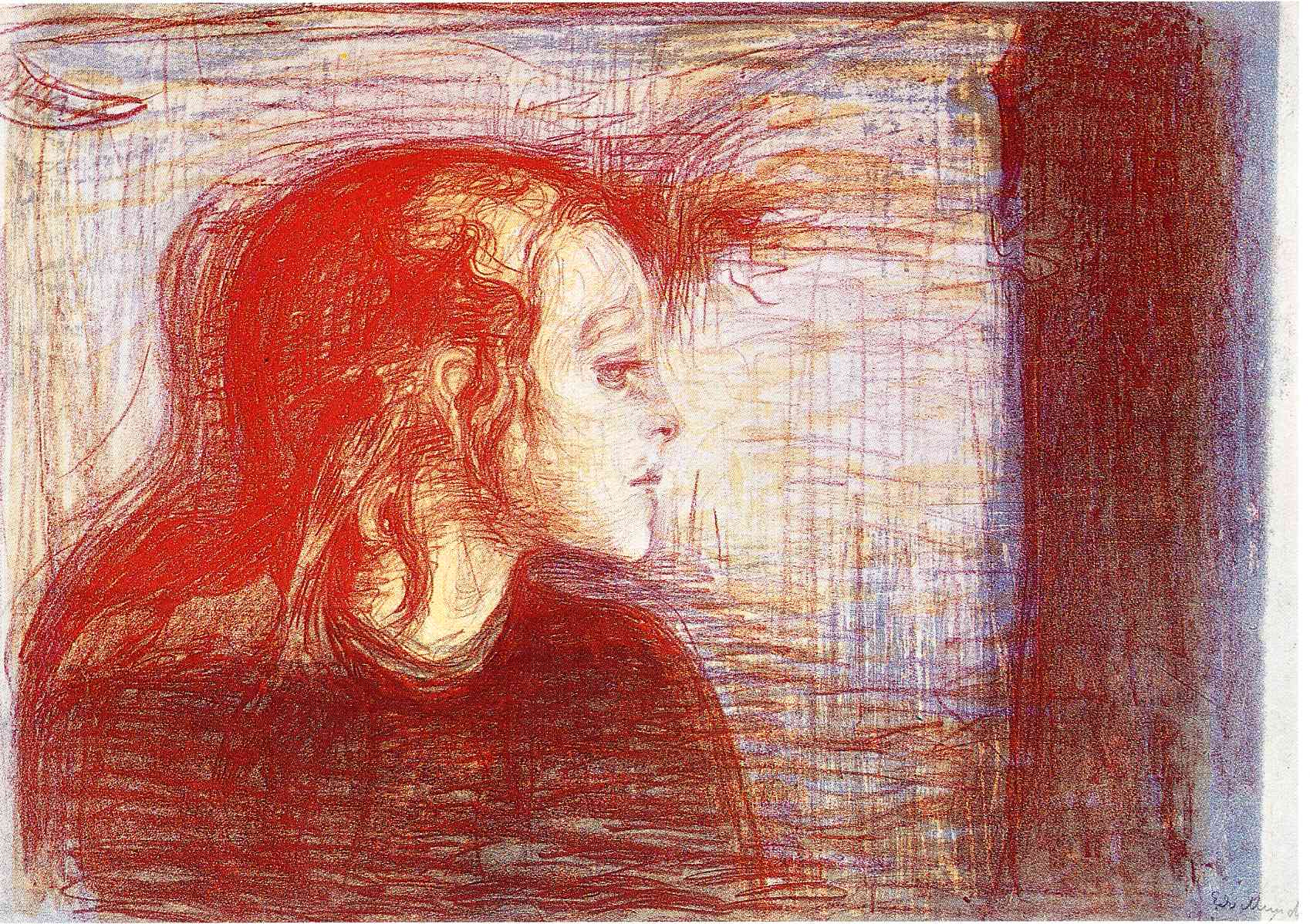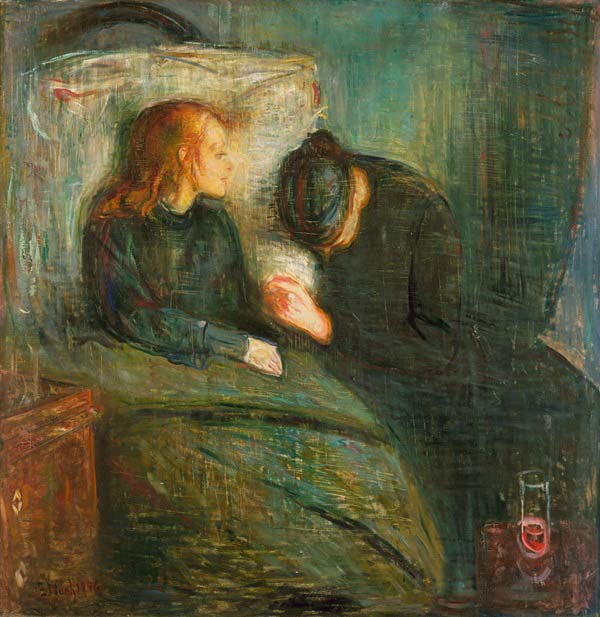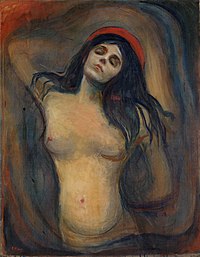Modernism, San Francisco
August 31 - October 7, 2017
Modernism is presenting a major exhibition of
prints and drawings by the legendary Norwegian
artist Edvard Munch (1863 - 1944). Encompassing thirty works produced between 1894 to 19 30 , the exhibition complements aconcurrent retrospective of Munch's paintings at the San Francisco Museum of Modern Art.
Also see (Edvard Munch: Color in Context National Gallery of Art September 3, 2017, through January 28, 2018.)
Also see (Edvard Munch: Color in Context National Gallery of Art September 3, 2017, through January 28, 2018.)
The
Modernism exhibition features some of Munch's
most famous images, including The Sick
Child, Madonna, and The Kiss;
– painted versions of which are simultaneously on view at SFMOMA – affording viewers a rare opportunity to see how he treated key themes including death and love in diverse media.
Printmaking was central to Munch's practice, and works on paper were as significant to him artistically as oils on canvas. Over the course of five decades, beginning in 1894, he printed some eighteen thousand impressions, representing hundreds of motifs, realized as etchings, lithographs, woodcuts, and mixtures of these techniques.
The bulk of this oeuvre is now in Oslo's Munch Museum,, which inherited his personal collection upon his death. Decades of scholarship by that museum, as well as institutions such as the National Gallery of Art in Washington DC – have revealed the extraordinary richness of his graphic art, and its intimate relationship to his paintings and drawings. As Munch wrote in an 1889 diary entry, his artistic aim was to show "living people who breathe, feel, suffer and love".
By creating multiple variat ions on a print over a period of decades – and using prints as inspiration for subsequent drawings and paintings and prints – he was able to explore his innermost feelings through countless expressionistic permutations on the living people who stirred his own love and suffering.
This strategy can be seen from the very beginning of his printmaking career. For example, one of the earliest images in the Modernism exhibition, a drypoint etching titled

Death and the Woman (1894), derived from an ill - fated affair that he recorded in sketches in the late 1880s and

developed into a painting in 1893. Like the painting, his etching adapts the traditional theme of the Dance of Death, depicting a nude young woman passionately embracing a skeleton.
In the same year, Munch extracted the emotional essence of his composition, setting aside the symbolism, in a painting called The Kiss.

This painting in turn became the basis for an 1895 etching, also on view at Modernism, showing the fervid embrace of a nude couple.

Over the years that followed, Munch continued to develop the motif using a broad range of techniques. One of the most important was the woodcut, which facilitated greater abstraction.

A 1902 version, in which the couple has been clothed in black, can be seen at the Modernism exhibition

(and compared to a similar painting from 1897 on view at SFMOMA).
While the identity of the lovers in The Kiss is hidden – and the connection to Munch's own life is essentially poetic – other works by Munch are explicitly autobiographical, perhaps none more so than

Edvard Munch, The Sick Child, 1885–86. The original version. Nasjonalgalleriet, Oslo.
This image originated with the death from tuberculosis of Munch's older sister Johanne Sophie in 1877. He was greatly traumatized by the experience, and began painting his memory of Johanne Sophie on her deathbed as early as 1885.

Edvard Munch, The Sick Child, 1896. The second painting was completed while the artist was living in Paris, Konstmuseet, Gothenburg.
A decade later he focused in on her haunted face – emphasizing her gaze into the darkness ahead – in a color lithograph that he considered to be his "greatest print".
The four - color version on view at Modernism, printed in 1896, can be compared to
a painted version from the same year at SFMOMA, which shows the graphic influence of Munch's printmaking experience on his contemporaneous canvasses.

Edvard Munch. The Sick Child. 1897
– painted versions of which are simultaneously on view at SFMOMA – affording viewers a rare opportunity to see how he treated key themes including death and love in diverse media.
Printmaking was central to Munch's practice, and works on paper were as significant to him artistically as oils on canvas. Over the course of five decades, beginning in 1894, he printed some eighteen thousand impressions, representing hundreds of motifs, realized as etchings, lithographs, woodcuts, and mixtures of these techniques.
The bulk of this oeuvre is now in Oslo's Munch Museum,, which inherited his personal collection upon his death. Decades of scholarship by that museum, as well as institutions such as the National Gallery of Art in Washington DC – have revealed the extraordinary richness of his graphic art, and its intimate relationship to his paintings and drawings. As Munch wrote in an 1889 diary entry, his artistic aim was to show "living people who breathe, feel, suffer and love".
By creating multiple variat ions on a print over a period of decades – and using prints as inspiration for subsequent drawings and paintings and prints – he was able to explore his innermost feelings through countless expressionistic permutations on the living people who stirred his own love and suffering.
This strategy can be seen from the very beginning of his printmaking career. For example, one of the earliest images in the Modernism exhibition, a drypoint etching titled

Death and the Woman (1894), derived from an ill - fated affair that he recorded in sketches in the late 1880s and
developed into a painting in 1893. Like the painting, his etching adapts the traditional theme of the Dance of Death, depicting a nude young woman passionately embracing a skeleton.
In the same year, Munch extracted the emotional essence of his composition, setting aside the symbolism, in a painting called The Kiss.

This painting in turn became the basis for an 1895 etching, also on view at Modernism, showing the fervid embrace of a nude couple.

Over the years that followed, Munch continued to develop the motif using a broad range of techniques. One of the most important was the woodcut, which facilitated greater abstraction.

A 1902 version, in which the couple has been clothed in black, can be seen at the Modernism exhibition

(and compared to a similar painting from 1897 on view at SFMOMA).
While the identity of the lovers in The Kiss is hidden – and the connection to Munch's own life is essentially poetic – other works by Munch are explicitly autobiographical, perhaps none more so than

Edvard Munch, The Sick Child, 1885–86. The original version. Nasjonalgalleriet, Oslo.
This image originated with the death from tuberculosis of Munch's older sister Johanne Sophie in 1877. He was greatly traumatized by the experience, and began painting his memory of Johanne Sophie on her deathbed as early as 1885.

Edvard Munch, The Sick Child, 1896. The second painting was completed while the artist was living in Paris, Konstmuseet, Gothenburg.
A decade later he focused in on her haunted face – emphasizing her gaze into the darkness ahead – in a color lithograph that he considered to be his "greatest print".
The four - color version on view at Modernism, printed in 1896, can be compared to
a painted version from the same year at SFMOMA, which shows the graphic influence of Munch's printmaking experience on his contemporaneous canvasses.

Edvard Munch. The Sick Child. 1897

'The Sick Child', Edvard Munch, 1907 | Tate
To realize his complex compositions, Munch often depended on models, who could act out his memories and fantasies as he captured their emotional undercurrents.
One of those models, Ingeborg Kaurin, can be seen in a charcoal drawing at Modernism. The drawing takes the title of the nickname Munch gave her, Mossepiken, and may have been a study for paintings such as
The Forerunner, a 1913 self - portrait in which he fondles an uncomfortable peasant girl.

Munch was also an adept portraitist. The Modernism exhibition includes a pastel of the Norwegian singer Marta Sandal, captured in 1902, the year she was discovered by Edvard Grieg, launching her illustrious career.)
Munch's remarkable creativity over six productive decades resulted in myriad innovations in both form and content, which greatly influenced painters and graphic artists of his own era, including Emil Nolde and Ernst Ludwig Kirchner . More recently his work has inspired contemporary artists ranging from Georg Baselitz to Marlene Dumas to Jasper Johns. Yet the person he inspired most, and who was most inspired by him, was Edvard Munch himself.
The exhibition at Modernism vividly illustrates that virtuous circle of self - influence.
Madonnas
(see below).
Paintings:
Version from Munch Museum, Oslo. 1894. 90 cm × 68 cm (35 in × 27 in). It was stolen in 2004 and recovered two years later.
Version from National Gallery of Norway, Oslo. 1894–95. 91 cm × 70.5 cm (36 in × 27.8 in).
Version from Kunsthalle Hamburg, Hamburg. 1895. 90 × 71 cm (35.4 × 28 in)







